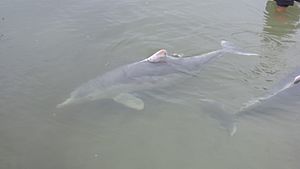Australian humpback dolphin facts for kids
Quick facts for kids Australian humpback dolphin |
|
|---|---|
 |
|
| Australian humpback dolphins, Tin Can Bay, Queensland, Australia, 2016 | |
| Conservation status | |
| Scientific classification | |
| Genus: |
Sousa
|
| Species: |
sahulensis
|
The Australian humpback dolphin (Sousa sahulensis) is a type of humpback dolphin. It's the fourth species of humpback dolphin that scientists have officially recognized. Its scientific name, sahulensis, comes from the Sahul Shelf. This is an area of shallow ocean between northern Australia and southern New Guinea, which is where these dolphins live.
Scientists officially described this species on July 31, 2014. This important discovery was published in a science journal called Marine Mammal Science. As of August 2014, experts didn't have an exact count of how many Australian humpback dolphins there are. However, based on how often they were seen, it was estimated there were "a few thousand" of them.
Contents
What Do Australian Humpback Dolphins Look Like?
Australian humpback dolphins have some unique features that set them apart from other humpback dolphin species. These differences include their total length, the number of teeth they have, and the bones in their spine (vertebrae). They also live in different parts of the world.
The fin on their back, called the dorsal fin, is lower and wider at its base compared to the Atlantic humpback dolphin and the Indian Ocean humpback dolphin. Their body is mostly dark gray. Interestingly, their closest relative, the Chinese white dolphin, is usually white, sometimes with a pink color. Australian humpback dolphins also have a special dark mark on their back that looks a bit like a cape.
These dolphins can grow to be about 3.5 to 9 feet (1 to 2.7 meters) long. Their dorsal fin is short and shaped like a triangle. Unlike some other humpback dolphins, they don't have a big "hump" on their back. Their body is mainly dark gray, fading to lighter gray on their sides. A diagonal line separates their dark back from their lighter belly. Adult dolphins often have white scars and dark spots on their head, back, dorsal fin, and tail. When they are born, they weigh between 88 and 110 pounds (40–50 kg). As adults, they can weigh between 507 and 550 pounds (230–250 kg).
How Do Australian Humpback Dolphins Live?
Australian humpback dolphins can mate and have babies all year round. A mother dolphin carries her baby for about 10 to 12 months before it's born. Baby dolphins might drink their mother's milk for more than two years. It's likely that a mother dolphin has a new baby every three years. These dolphins can live for at least 30 years.
Scientists spent 17 years studying these dolphins before they finally realized that S. sahulensis was its own separate species. DNA analysis was very helpful in figuring this out. By looking at their genes, scientists found unique differences that proved they were a new species.
What Do Australian Humpback Dolphins Eat?
These dolphins are known to be flexible eaters. They eat many different types of fish that live near the coast, in river mouths, and around reefs. They can hunt for food in various places, like mangrove forests, sandy riverbeds, seagrass meadows, and coral reefs close to shore. Sometimes, they spread out to find food over a large area. Other times, they form tight groups to hunt specific prey. These marine mammals have even been seen chasing fish into very shallow water and briefly beaching themselves to catch their meal!
Protecting Australian Humpback Dolphins
There isn't a total number for the global population of these dolphins. However, estimates for smaller groups are only in the low hundreds. Because they live close to the coast, Australian humpback dolphins face many dangers. These include getting caught by accident in fishing nets, losing their homes (habitats), getting hit by boats, pollution, and changes in the climate. Now that this Aussie dolphin has an official species name, it has a better chance of getting special help to protect it.
How Do Australian Humpback Dolphins Behave?
Australian humpback dolphins have been seen doing something called strand-feeding. This is when they chase fish onto the shore to catch them.
They are generally shy and tend to stay away from boats. Humpback dolphins have also been observed showing mating behaviors with Australian snubfin dolphins.
See also
 In Spanish: Delfín jorobado australiano para niños
In Spanish: Delfín jorobado australiano para niños


